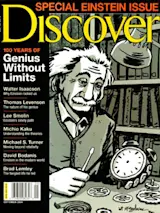Relativity and quantum mechanics rank among the greatest achievements of 20th-century science, constituting the sum of all fundamental physical knowledge. The former describes the world of the very large, including black holes and the expanding universe. The latter explains the world of the very small, the microscopic realm of atoms and subatomic particles. One man—Albert Einstein—was the undisputed father of the first theory and the godfather of the second.
What was the secret of Einstein’s success? He once said that if a physical theory cannot be explained to a child, it is probably worthless. In other words, he thought in terms of simple physical pictures. His greatness lay in his ability to use such pictures to solve fundamental problems, such as the conflict between Isaac Newton’s theory of mechanics and James Clerk Maxwell’s theory of light.
The Newtonian system was based on common sense—that a second on Earth is the ...














